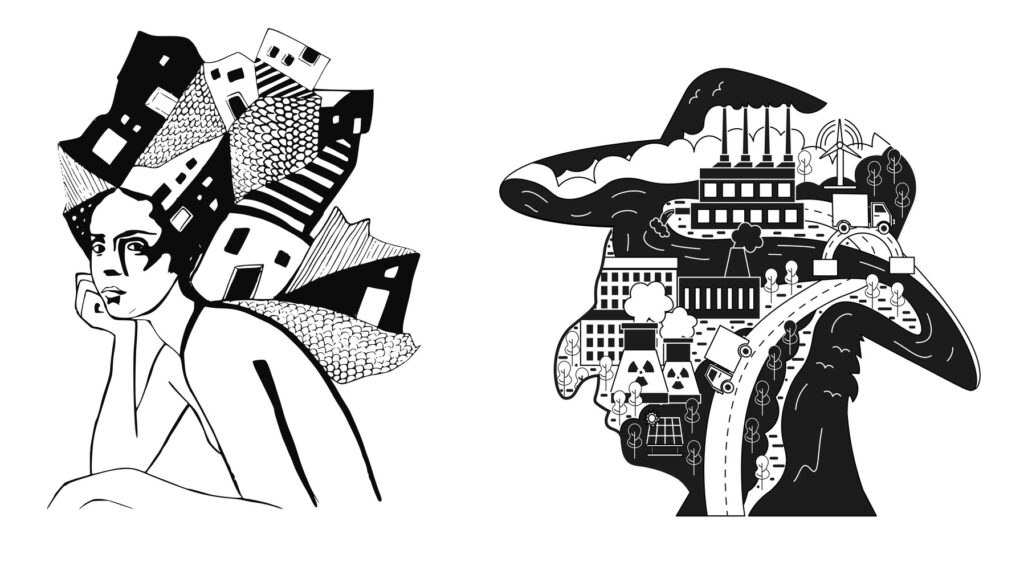Prominent international psychiatrists led by Ana Gómez-Carrillo and Laurence Kirmayer of McGill University in Québec recently published a theoretical article in Lancet Psychiatry proposing a new way for psychiatry to push past biological reductionism.
They present an integrative cultural-ecosocial system approach to conceptualizing cases and providing person-centered care. The authors note the current issues with reductionist neuroscientific paradigms in psychiatry that prioritize biomedical approaches to explain psychopathology at the expense of patients’ experience and social context.
“Any analysis of brain function that separates neurobiology from the social environment limits clinical understanding, ignores major determinants of health, and restricts scientific advances in therapeutics, including biological, psychological, and social interventions,” the authors write. “This dilemma has been recognized even by staunch advocates of the potential for psychiatry as ‘clinical neuroscience.’ Illness trajectories depend on developmental processes, learning, and behavioral interactions on multiple spatial and temporal scales, which involve levels of the organization across neurobiological, cognitive–affective, interpersonal, and social systems.”
 To address the social factors of clinical presentations, the field has felt pressure to improve clinicians’ cultural and structural competencies in their practice. Alternative models of psychopathology have also been proposed, which offer critical perspectives that more fully consider the social and historical conditions involved. However, it’s largely unclear how these contexts directly impact someone’s psychology or biology. While taking a biopsychosocial approach to clinical care is often suggested as routine practice, it is critiqued for its conceptual vagueness and lack of integration between the three levels of biology, psychology, society, and culture.
To address the social factors of clinical presentations, the field has felt pressure to improve clinicians’ cultural and structural competencies in their practice. Alternative models of psychopathology have also been proposed, which offer critical perspectives that more fully consider the social and historical conditions involved. However, it’s largely unclear how these contexts directly impact someone’s psychology or biology. While taking a biopsychosocial approach to clinical care is often suggested as routine practice, it is critiqued for its conceptual vagueness and lack of integration between the three levels of biology, psychology, society, and culture.
The authors put forward an ecological approach that meaningfully integrates biological, social, and cultural systems by integrating concepts from dynamic systems, cognitive science, computational neuroscience, and cultural psychiatry. This cultural-ecosocial system approach is meant to provide a framework to guide clinicians by informing case formulations that are used to understand and treat their patients.
Through ecology, we can understand how organisms and systems dynamically interact and influence one another over time in loops that shape an individual’s psychology. This ecological perspective can help clinicians understand and treat patients in psychotherapy from a less individualistic perspective. Using perspectives in dynamic systems and cognitive science, this approach expands the ecological model by considering the processes of embodiment, enactment, embeddedness, and extension to integrate the levels of organization in the biopsychosocial. The authors elaborate on these concepts:
“In social epidemiology, the concept of embodiment represents the many ways in which social structure and interaction during the lifespan affect bodily processes both directly (through physiological effects) and indirectly (through processes of learning and attention that are mediated by culture and context). In addition to this approach, 4E cognitive science recognizes that the body’s structure and physiology affect cognition, behavior, and experience. These effects result in cycles of interaction—or loops—between bodily physiology (i.e., embodiment) and modes of self-presentation and self-construal (i.e., enactments), which are embedded in and extended through active engagements with social contexts and the wider environment.”
Individuals physically embody the environments they’re embedded within, shaping their thoughts. Individuals enact this embodiment by constructing their perceptions of the world and themselves, which leads them to adaptive action and extend themselves within specific relational systems. This includes learning subtle ways to communicate with others in your social network for purposes of emotion regulation and decision-making support.
Clinical formulations from this cultural-ecosocial perspective are focused on describing these causal loops between embedded embodiment and extended enactment. Treatment can then be targeted to change these loops in ways that lead to better regulatory dynamics. Since a large part of treatment effectiveness rests on how patients interpret their experience, the authors stress that clinicians should focus on patient subjectivity, agency, self-understanding, and social positioning along with neurobiology to account for psychopathological processes.
Personal and cultural meanings of illness and health influence the course of illness, help-seeking, and treatment expectations, as evidenced when patients use biomedical explanations for their experience. Thus, cultural formulations, including those focusing on structural determinants of health, are crucial to the culture-ecosocial approach to clinical work.
According to the authors doing such work “requires systematic attention to the interaction of four key dimensions of social and cultural context.” They elaborate:
“First, the lifespan developmental dimension includes individual variation in developmental exposures, learning, personal history, life-course events, transitions, and trajectories. Second, the social–structural dimension includes structural, contextual, and interactional determinants of vulnerability, adversity, precarity, and resilience. This dimension also encompasses exposure to stigmatization, racism, discrimination, marginalization, and oppression, as well as support, empowerment, and access to resources. Third, the cultural–historical dimension includes the embedding of health and illness in social, cultural, and historical systems of meaning, knowledge, and practice, which affect illness explanations, coping, help-seeking, treatment expectations, and response to interventions. Fourth, the experiential dimension includes individuals’ experience of illness, self-understanding, awareness, and ways of living with their symptoms in the context of their lifeworlds.”
Biological, psychological, and social processes are thought to be subsystems of a larger multilevel system where events on one level can cause an effect on any other level. Clinicians are to identify and engage in these loops between levels that are most clinically relevant and useful to make sense of the patient’s presentation. Through evaluating evidence for factors from these different levels causing the persistence or exacerbation of symptoms, clinicians can build a dynamic understanding of these cyclical psychopathological processes.
As the patient changes in response to treatment, in how they understand the nature of their symptoms, and their overall life circumstances, clinicians can evolve their formulations to guide further assessment and treatment. The authors provide a case example to illustrate how this cultural-ecosocial systemic approach can be applied to case formulation centering on embodiment, enactment, embedding, and extension on integrating these systems.
****
Gómez-Carrillo, A., Kirmayer, L. J., Aggarwal, N. K., Bhui, K. S., Fung, K. P.-L., Kohrt, B. A., Weiss, M. G., & Lewis-Fernández, R. (2023). Integrating neuroscience in psychiatry: A cultural–ecosocial systemic approach. The Lancet Psychiatry, 10(4), 296–304. https://doi.org/10.1016/S2215-0366(23)00006-8 (Link)















Psychiatry needs to learn one thing: wordiness only goes so far.
Report comment
A very good article but there are some apprehensions….
Quote from article above…
“INDIVIDUALS physically embody the environments they’re embedded within, shaping THEIR thoughts”.
A vision is that people are told that their environment has caused their behaviour and it is not their own fault. There is a beautiful blessing in this way of understanding the impact of environment…
But like any blessing it can be turned into a mode of yet more social control…to tell an individual that because THEY do not change their environment, the one that is reputed to be causing their behaviour, they are complicit in indulging in their overly liking their environment the way it is and overly liking their behaviour the way it is. This attitude against the individual leaves them vulnerable to attacks from “consensus opinion puppets on strings” who claim that the individual’s behaviour is a sign of not “being a joiner in consensus opinion” and therefore this cycles back to a new/old prevailing view of the individual’s behaviour being all their own fault.
Over in desperately totalitarian religious places in the world some “individuals” are scrutinized by overseers for coming out with “the wrong thoughts”…from putatively lazing around in the wrong dens of iniquity in the wrong decadent environments. Until their individualism is taken as a sign of their spreading troubling behaviour.
Do you not see how ANY fine idea such as the one in this article can quickly become used by any fresh bullies to impose authority over any person’s private (and I quote) …”shaping thoughts”?
Long long ago, during the historical epoch of the Spanish Inquisition, herbalists and hippies and lustful wenches and ner-do-well jack of all trades, were harassed for being physically EMBODIED and EMBEDDED in “sinful” environments, fleshpots, inns and bars, reputed to “cause” their behaviour. Some of those eccentrics were then maligned by authorities for having insolent “individual” propensities. The authorities said that the Christain environment came first and foremost before any individual. The EMBODIED and EMBEDDED miscreats were hauled into priestly courts to pinprick their tender places to locate the devil of their INDIVIDUAL cries.
The word “environment” always tends to get a pious “vision” lashed on to it, a vision of how the environment SHOULD BE, and this then can become a way of telling individuals within that environment how they ought to clean up their act and become “saved”.
A new form of zealous reductionism that overly scrutinizes the private and personal freely chosen “shaping thoughts” of individuals may try on the ecclesiastical shiny shoes of past reductionism.
That does not mean beware all visions or beware all “consensus opinions” or beware all religions or beware all politics or beware all spirituality. It only means beware of how easily bullying can hijack ANY compassionate fine idea.
Report comment
Who needs psychiatry—reductionist or otherwise—when a little Jung is all you need?
On YouTube: “Carl Jung – How to Find Your Soul”, courtesy After Skool
Report comment
Get a load of this:
“Illness trajectories depend on developmental processes, learning, and behavioral interactions on multiple spatial and temporal scales, which involve levels of the organization across neurobiological, cognitive-affective, interpersonal, and social systems.”
Translation: LOOK AT THE BIG PICTURE
And while you’re at it, try having a little respect for the people you’re dealing with.
Report comment
In my own opinion…and it is only my opinion…
Illness trajectories ALSO depend on BULLYING and ANY bully can use the academic study of and governance of learning, behavioural interactions and levels of organization across neurobiological, cognitive-affective, interpersonal and social systems to oppress the INDIVIDUAL who has a DIFFERENCE of OPINION.
A difference of opinion is a free basic human right. An opinion may come as a cluster of opinions that form “a vision” for the best way forward in future. There are over eight billion people on the planet. There are inevitably therefore far more than just a stock handful of mainstream “visions” for how to make life better. The battle over “visions” occurs because of the impulse to glorify “consensus opinion”. This then causes a tension between individuals who want their freedom of choice to have a different opinion from the “consensus opinion” and the masses who have a collective consensus “vision”. When the masses oppress individuals of difference you have bullying and persecution. These things tend to make individuals feel ill.
Bullying is THE ONLY thing society ought to ban. Freedom to have different opinions or a different vision is NOT the same thing as bullying. The freedom for every neighbour to create and enjoy their own opinions and their own vision is part of what forms optimal wellbeing. We are not all the SAME. An interesting vision to one individual may seem stifling to another individual. It does not mean the vision is “wrong” or “right”. It is just “different”.
ONLY bullying is “wrong” and never “right”. When a person or group tries to have their vision dominate everyone else, as the ONLY vision or ONLY “consensus opinion”, then that moves the opinion or vision from just being “a dream of improvement” into being a set of domineering, authoritarian, oppressive RULES.
The ONLY RULE any society ought to be united in keeping is the RULE against actual abuse, bullying and cruelty.
A person does not need any ideology or religion or philosophy to keep that RULE.
A two year old child knows when it is encountering abuse, bullying or cruelty. A child is an INDIVIDUAL who does not need “consensus opinion” to know when it is being badly treated. A child is an INDIVIDUAL who does not need to “intellectually know of” or “respect” THE BIG PICTURE to understand when its opinions or visions are being bullied.
Like I said before, it is fine to have different opinions, visions, beliefs, faiths, politics, campaigns, consensus opinions. It is never fine to bully people who are EQUAL in their being different and who therefore do not hold the same views.
What people tend to ALL agree upon is that violence and oppression ARE bullying and that for a peaceful future bullying must stop. It must cease because there are always other ways of furthering a good idea than punishing those who feel differently. The real enemy in the world is NOT all the many differences. The real enemy is JUST the bullying, persecution of those with harmless many differences. But what happens is that people convince each other that an INDIVIDUAL being a bit different is a sign of their being wicked or sinful or a bully. People then crack down on that individual as if doing so stops bullying in the world. But that very propensity to collectively crack down on someone with a harmless different opinion BECOMES BULLYING.
Intolerance of harmless differences of opinion is something that “consensus opinion” rustles up. This is because “consensus opinion” promises a sense of “belonging to a group”, and this has attractions to anyone who has experienced bullying in their life. Binding with a greater collective promises an antidote to existential helplessness. But that collective can later force RULES upon INDIVIDUALS whose opinions stray outwith the enshrined “consensus opinion”, and such RULES can be millions of fussy regulations about what to wear and what words to use and what people to befriend…until all those rules and regulations make a person lose sight of the ONLY most important RULE to be united in standing FOR…the RULE against telling other people how to be or feel or think…the RULE against abuse, bullying and cruelty.
A human cannot have it both ways, a human cannot be against bullying and yet telling everyone with various harmless differences of “vision” or “feeling” or “opinion” that they “have to” think or be or feel identically like they do.
The article above offers a “vision” for the future. I am saying most “visions” are okay. I am ALSO saying that because “visions” can form into collective “consensus opinion” that there is ALWAYS going to be a risk that a bully leader will be drawn to such a collective group due to the inherent mass POWER available in such a gathering and proceed to champion it to the total exclusion of any other option or “vision”. This can then lead to a crack down against individual freedom of choice. Any human needs access to their individual freedom of choice in order to feel optimal wellbeing and good health and in order not to feel like a puppet on a string. Any human is like a child within and no child relishes being told to think or feel or believe things it simply does not.
Report comment
https://youtu.be/505UazMNgLg
This is a jolly interesting interview.
The Hoover Dam is going to be blown up. I foresee it. When it does then believe I have the thread of the way the world is going.
I am composing this note a short while after posting my comment reply/opinion on “illness trajectories”.
In the future is coming…
A TOTALITARIAN REGIME.
At first it will seem like the answer to everyone’s anxious concerns. For that reason everyone will be encouraged to support it. Everyone will be ordered to change so that globally everyone manifests it. The cheering on by crowds of adoring spectators of its initial victory will obscure the future of abhorrent cruelties and mass deaths that will be ushered in by the REGIME.
We may try to take a stand against such future cruelty but there will come a point where doing such peace work will be too dangerous. There will come a stage where the only safe way to express revulsion at such widespread depravity and violence is to be totally SILENT.
Report comment
Reductionism is not the answer. But neither is brain clutter.
Report comment
You gotta hand it to psychiatry trying to walk back its biological reductionism. But it’s definitely overcompensating.
Here’s what most people truly need: space and time to grieve unprocessed emotions – – unmolested by psychiatry’s intrusive machinations, pharmaceutical or otherwise.
Report comment